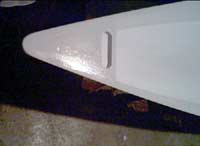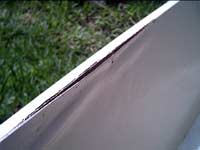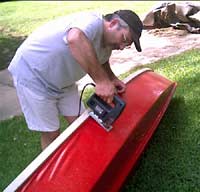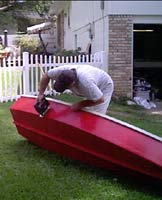Death of a Cheap Canoe
or
Why Moisture-Resistant Plywood Should Not Be Used in Boatbuilding
by Rick Cunningham
Two summers ago I had the itch to build a stitch and glue boat. A really bad itch. Though I already had plans for Vamp and Rogue, time and funds were limited. Besides, I wanted to practice with all the tape and goop before starting on a large (for me) project. The Cheap Canoe from Bateau.com seemed to be an ideal project. Simple cuts, only 3 panels, and very well documented—and FREE plans—such a deal.
I also wanted to test the epoxy vs. polyester issue for myself, and what better way to do this than on a small boat with only two long seams and identical stem seams on either end. So, I got online and ordered a roll of 3” tape and went to the local Lowe’s for a gallon of Bondo Home Solutions resin. Great, now all I needed was wood.
At the time I could not find ANY exterior luaun in decent shape anywhere in town, and all the exterior fir and pine was pretty warped. Enter Home Depot’s Virola ply, with which they replaced luaun for underlayment. Very nice-looking wood, but it was stamped Type II MR, and none of the local Home Depot people could tell me whether they’d have any with exterior glue coming in. Hmmmm….
I wanted to get this thing built, so I went ahead and built it with the Virola ply and poly resin. I figured this would be a good test of the polyester, and of building the boat as cheaply as possible. The idea of using duct tape in place of stitches seemed like a good
idea too—and worked well except for the stem seams—go ahead and use stitches there if you build a Cheap Canoe.
|
Lo and behold, in just a few days, I had a Cheap Canoe. |
|
|
The only challenge was deciding what to do about breasthooks. I also added a keel. |
 |
|
|
The boat tracked well, and did everything I suppose you could expect from a boat like this. |
|
|
Over the winter it sat outside on sawhorses, covered with a tarp. I noticed one small place on the sheer where the ply was delaminating just a bit. |
 |
|
|
|
“No big deal”, I thought, “I’ll just fix that in the spring”. |
|
Wrong!
When I turned the boat over 4 months later, my poor Cheap Canoe was beyond help. Over the winter the Moisture Resistant Virola ply… well, you see the results. I thought for a few days about how to salvage what I’d built and had only had in the water maybe a half dozen times. Finally, I had to just accept that there was nothing I could do to save her.
|
So we had a brief ceremony where I read a few words from Build the New Instant Boats. |
|
|
Then I chased our dog out of the canoe and brought out the saber saw. |
 |
|
|
The two pointy ends took on new roles as oversized garden gnomes as a joke, but the job seems to suit them so they’re still standing watch, now for over a year. |
|
The polyester seams have held up just fine, even after being in direct contact with the ground all this time. The oil based Krylon paint also never has any mold on it. My other 3 boats are painted with latex, and I have to break out the bleach at least once during our long, humid Alabama summers. So maybe there is one advantage to oil based enamel, though the 50/50 bleach/water makes short work of mold on the latex.
|
Sure is a lot faster than building it. |
 |
|
Two of my surviving boats were built from 5.2mm luaun exterior underlayment, the other from 6mm BS1088 Meranti. No delamination problems with them at all, and one of them is taped seams with all Bondo and polyester resin—stored outdoors, uncovered.
So for all the debate of epoxy vs. polyester vs. screw and glue, none of that matters if the wood can’t stay together. So choose your wood carefully, and if you can’t find what you really need at the moment be patient and keep looking.
|
Better to delay building by a few days than to have a premature boat funeral! |
 |
|

